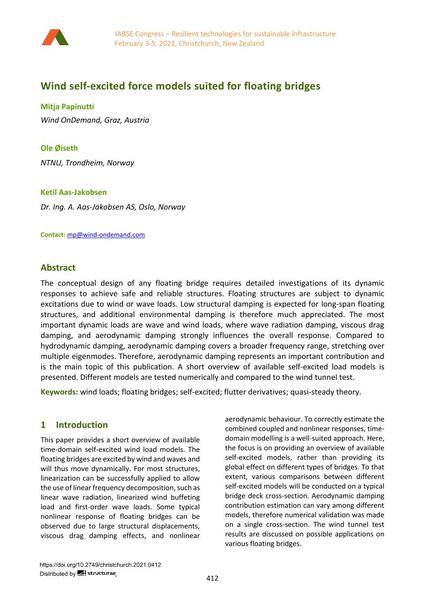Wind self-excited force models suited for floating bridges

|
|
|||||||||||
Bibliografische Angaben
| Autor(en): |
Mitja Papinutti
(Wind OnDemand, Graz, Austria)
Ole Øiseth (NTNU, Trondheim, Norway) Ketil Aas-Jakobsen (Dr. Ing. A. Aas-Jakobsen AS, Oslo, Norway) |
||||
|---|---|---|---|---|---|
| Medium: | Tagungsbeitrag | ||||
| Sprache(n): | Englisch | ||||
| Tagung: | IABSE Congress: Resilient technologies for sustainable infrastructure, Christchurch, New Zealand, 3-5 February 2021 | ||||
| Veröffentlicht in: | IABSE Congress Christchurch 2020 | ||||
|
|||||
| Seite(n): | 412-419 | ||||
| Anzahl der Seiten (im PDF): | 8 | ||||
| DOI: | 10.2749/christchurch.2021.0412 | ||||
| Abstrakt: |
The conceptual design of any floating bridge requires detailed investigations of its dynamic responses to achieve safe and reliable structures. Floating structures are subject to dynamic excitations due to wind or wave loads. Low structural damping is expected for long-span floating structures, and additional environmental damping is therefore much appreciated. The most important dynamic loads are wave and wind loads, where wave radiation damping, viscous drag damping, and aerodynamic damping strongly influences the overall response. Compared to hydrodynamic damping, aerodynamic damping covers a broader frequency range, stretching over multiple eigenmodes. Therefore, aerodynamic damping represents an important contribution and is the main topic of this publication. A short overview of available self-excited load models is presented. Different models are tested numerically and compared to the wind tunnel test. |
||||
| Stichwörter: |
Windlasten
|
||||
